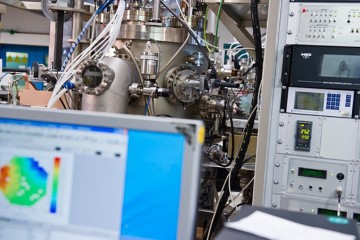- Ruhr-Universität Bochum

A view of the sputtering facility at RUB that was used to produce the material libraries.
© Christian Nielinger
A Treasure Map for the Realm of Electrocatalysts
The number of possibilities complicates the search for promising materials. A German-Danish team has developed an efficient method for doing so.
Efficient electrocatalysts are hidden in materials composed of five or more elements, which are needed, for example, for the production of green hydrogen. A team from Ruhr University Bochum (RUB) and the University of Copenhagen has developed an efficient method for identifying promising candidates in the countless possible materials. To do this, the researchers combined experiments and simulation. They report in the journal Advanced Energy Materials, January 5, 2022.
Millions of systems are conceivable
High-entropy alloys, or HEAs, are chemically complex materials consisting of mixtures of five or more elements. The interesting thing about them is that they offer completely new possibilities for the development of electrocatalysts. These are urgently needed to make energy conversion processes more efficient, such as for the production and use of green hydrogen. "The problem with HEAs is that, in principle, millions of high-entropy systems are possible, and each system involves tens of thousands of different compositions," explains Prof. Dr. Alfred Ludwig, who heads the Materials Discovery and Interfaces chair at RUB. Conventional methods and traditional high-throughput procedures can hardly cope with this complexity.
Five sources, six constellations
In their work, the researchers describe a new method to help identify promising high-entropy alloys for electrocatalysis. In the first step, the team developed a way to produce as many potential compositions as possible. To do this, they used a sputtering system that simultaneously applies the five starting materials involved to a carrier.
The RUB electrochemistry team then examined the carriers coated in this way for their electrocatalytic activity and stability. To get even closer to the composition of the materials, the team matched these data from the experiment with a large simulation data set provided by the researchers at the University of Copenhagen.
